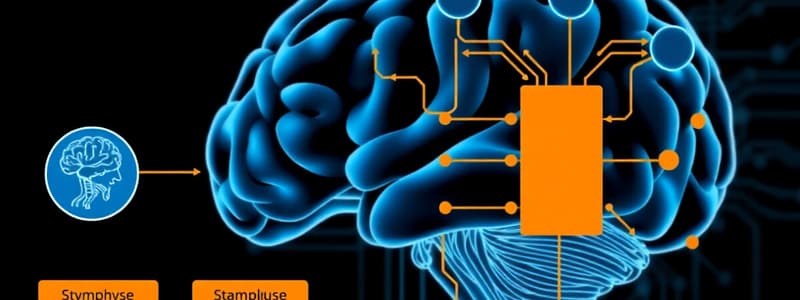Podcast
Questions and Answers
Which stage of information processing in the motor system focuses on translating sensory inputs into appropriate movement outputs?
Which stage of information processing in the motor system focuses on translating sensory inputs into appropriate movement outputs?
- Response selection (correct)
- Motor execution
- Stimulus identification
- Response programming
What is primarily analyzed during the stimulus identification stage of information processing?
What is primarily analyzed during the stimulus identification stage of information processing?
- Planning the movement sequence
- Selecting the desired response strategy
- Determining the presence and nature of the stimulus (correct)
- Identifying the appropriate motor units
In the context of information processing, identify which mechanism primarily assists in the organization of motor outputs.
In the context of information processing, identify which mechanism primarily assists in the organization of motor outputs.
- Lower level mechanisms such as brainstem (correct)
- Visual processing centers
- Cerebellum management
- Spinal reflex actions
Which component of reaction time reflects the delay between the 'go' signal and the observable muscle activity?
Which component of reaction time reflects the delay between the 'go' signal and the observable muscle activity?
What is the primary purpose of measuring reaction time in the context of information processing?
What is the primary purpose of measuring reaction time in the context of information processing?
What does Hick's Law state about reaction time as the number of stimulus-response (SR) alternatives increases?
What does Hick's Law state about reaction time as the number of stimulus-response (SR) alternatives increases?
Which factor is primarily affected by the speed-accuracy trade-off according to Fitt's Law?
Which factor is primarily affected by the speed-accuracy trade-off according to Fitt's Law?
How does increasing the distance to be moved affect movement time?
How does increasing the distance to be moved affect movement time?
Which statement best describes the relationship between speed and accuracy in rapid movements?
Which statement best describes the relationship between speed and accuracy in rapid movements?
What does the measure of reaction time (RT) encompass based on the given information?
What does the measure of reaction time (RT) encompass based on the given information?
Study Notes
Stages of Information Processing in the Motor System
- Information processing in the motor system occurs in discrete stages: stimulus identification, response selection, and response programming.
- These stages occur regardless of the environment.
Stimulus Identification
- This stage focuses on representing environmental information.
- The performer determines if there is a stimulus and identifies it.
- It analyzes stimuli from various sources, including visual, tactile, auditory, proprioceptive, olfactory, etc.
- It assembles components of the dimension (edges/colors, direction, speed).
Response Selection
- This stage translates sensory inputs into movement outputs.
- The performer decides what response is needed.
- It chooses the appropriate response based on the situation (e.g., catch, pass, etc.).
Response Programming
- Organizes a plan of action to control the movement.
- Signals are sent to muscles with the correct timing, force, etc.
- Mechanisms in the brainstem and spinal cord are involved.
Reaction Time (RT)
- Measures the time taken to prepare and initiate a movement from the stimulus onset.
- It identifies the environmental context used in response preparation.
- It assesses the individual's ability to anticipate an action and determine when to initiate it.
- It is independent of movement time (MT).
Components of Reaction Time
- Pre-motor Time: The time between the stimulus and the onset of muscle activity.
- Motor Time: The time between the onset of muscle activity and the observable movement.
Types of Reaction Time Paradigms
- Simple RT: Only one stimulus and one response.
- Choice RT: Multiple stimuli and multiple responses.
- Discrimination RT: Multiple stimuli, but only one response for a specific stimulus.
Factors Influencing Reaction Time/Decision Making
- Number of Stimulus-Response (S-R) Alternatives: As the number of stimulus-response pairs increases, the time required to respond (choice RT) increases.
- Hick's Law: As the number of S-R alternatives increases, reaction time increases, but the increase gets smaller with each additional alternative.
Speed-Accuracy Trade-off
- As the speed of movement increases, accuracy decreases.
- Fitts' Law: Mathematically describes the speed-accuracy trade-off.
- As target width increases, movement time is faster.
- As distance to target increases, movement time is slower.
Possible Causes of Accuracy Deficits with Speed
- The performer may not have enough time to accurately process feedback.
- The performer may not have enough time to adjust the movement trajectory.
- The performer may not have enough time to correct errors.
Studying That Suits You
Use AI to generate personalized quizzes and flashcards to suit your learning preferences.
Related Documents
Description
Explore the three critical stages of information processing within the motor system: stimulus identification, response selection, and response programming. This quiz delves into how environmental information is identified and how appropriate responses are chosen and executed. Understanding these stages is crucial for grasping the intricacies of motor control.


